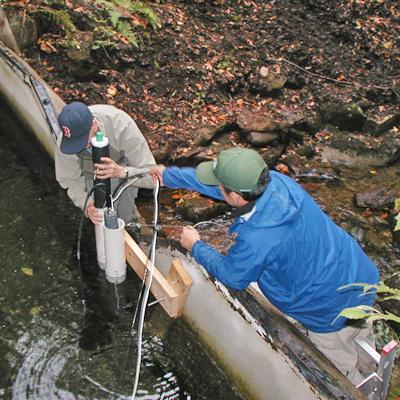Continuous in situ Measurement of Carbon Quality as a Tool for Understanding Stream Mercury Dynamics in Northern Forests

Like acid rain, mercury pollution enters the Northern Forest landscape in rain, snow, and dry deposition. Mercury is a neurotoxin that affects wildlife and humans who eat a lot of fish, in which mercury accumulates. NSRC researchers conducted this study to better understand magnitude, timing, and processes that lead to mercury leaving forest headwaters in streamflow, toward its ultimate uptake by fish downstream.
It takes many stream samples and expensive analysis to observe mercury behavior, so researchers sought an alternative method. Their previous work demonstrated that stream mercury was carried by dissolved organic carbon (DOC), the product of decaying plant and animal matter. Researchers used an in-stream fluorometer, an optical sensor that measures fluorescing dissolved organic matter (FDOM), which represents "reactive DOC" thought to carry mercury. They measured FDOM continuously at 15-minute intervals for one year at three long-term research watersheds that spanned a range of DOC and mercury: Hubbard Brook, NH (low DOC); Sleepers River, VT (intermediate DOC); and Arbutus, NY (high DOC).
The strong relation between measured FDOM and sampled DOC concentration allows researchers to use "continuous" FDOM values to calculate a DOC concentration at any point in time. The relation between FDOM and sampled mercury concentration was not as strong, but FDOM was nonetheless a reasonable measure for mercury. DOC and mercury concentrations closely followed changes in streamflow, increasing with storms and snowmelt and decreasing during dry periods. Fluorescence allows inexpensive assessment of how much DOC and mercury are released from Northern Forest headwaters and insight into how mercury movement may change in a changing climate.
Download printable version [PDF]
Download full final report [PDF]
